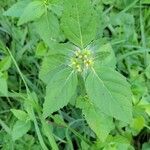Herbs, annual, 20-50 cm tall, Root fibrous, 7-10 cm × 2-3 mm thick. Stems single, many branched above base, 2-5 mm thick, minutely pubescent and sparsely setose. Lower leaves opposite; stipules minute, caducous; petiole 0.3-2 cm, minutely puberulent; leaf blade linear to ovate, 2-7 × 0.5-2 cm, adaxial surface often with purplish spot, both surfaces coarsely pilose on veins or glabrous, base attenuate, margin entire, repand-toothed, or shallowly lobed, very variable, with narrow marginal vein, apex acute or obtuse. Inflorescence terminal, cyathia in whorl of 2 or 3 congested 1-sided cymes; lower involucral leaves 2 or 3, similar to normal leaves; primary rays 2-4 cm; upper involucral leaves few, reduced. Cyathium stipe 1-4 mm; involucre campanulate, ca. 3 × 2 mm, lobes 5, triangular, lacerate; gland 1, lateral on margin of cup, light yellow-brown, cup-shaped, ca. 1.2 mm in diam. Male flowers many, exserted from involucre; anthers yellow. Female flower: ovary globose, glabrous; styles free; style arms 2-lobed. Fruiting pedicel short, as long as cup; capsule compressed globose, ca. 4 × 4-5 mm, glabrous. Seed ovoid-globose, ca. 2 × 1.5-2 mm, gray to almost black, papillate-tuberculate, adaxially black grooved; caruncle small, peltate, yellow, sessile. Fl. and fr. Jul-Oct. 2n = 28*.
Erect annual, 2–6 dm, often branched, with hairy herbage; lvs all or mostly opposite, petiolate, linear to ovate, coarsely toothed to subentire; infl congested, mingled with reduced green lvs; involucres 2–3 mm, with fimbriate lobes and a conspicuous, fleshy, flattened-obconic, tangentially bilabiate gland; styles bifid half their length, or deeper; fr smooth, 5 mm thick; seeds ovoid, rough-tuberculate, 2.5–3 mm, usually carunculate; 2n=14(?), 28, 56. Dry soil; Ill. and Wis. to Wyo. and Mex., and established as a weed on roadsides and waste places, especially in cindery soil, e to Mass., N.Y. and Va. July–Sept. (Poinsettia d.)

